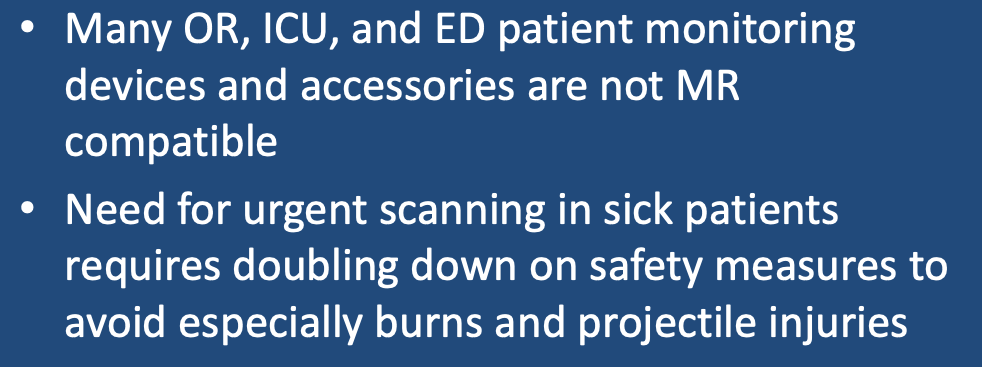The rush to scan critically ill patients from the recovery room, intensive care unit, or emergency department creates a scenario where MR safety may be potentially compromised. Such patients may have non-MRI compatible medical equipment on their bodies or unrecognized ferromagnetic materials in their gowns or clothing. Additionally, the rush to get such patients scanned quickly means that often a team of interns, nurses, and other non-MR-trained, non-MR-screened personnel may suddenly appear en masse at the MRI entrance. In such chaotic situations it is easy for even a skilled technologist to overlook a potential safety hazard. A partial list of such potential hazards include non-MRI compatible:
|
Pulse oximetry devices
EKG pads/leads Endotracheal tubes Swan-Ganz thermodilution catheters Arterial line transducers Foley catheters with temp sensor Rectal temperature probes Guidewires Medication patches Metal clamps for tubes |
External skeletal fixation devices
Halo vests Guidewires and stylets Ventilators Oxygen tanks Wheelchairs IV pumps Drainage devices Temporary transvenous pacing leads Thermal blankets |
In the event one or more of these potentially hazardous devices is encountered, they can often be easily substituted with an equivalent MR-compatible device (e.g., pulse oximeter or ventilator).
Fortunately, the vast majority of routine postoperative devices are nonmetallic and MR Safe, including most nasogastric tubes, endotracheal tubes, IV catheters, IV tubing, drains, and wound dressings. Many others, skin staples, wires, clips, metallic meshes, are made of non-ferromagnetic stainless steel or titanium alloys, so are (trivially) MR Conditional.
Advanced Discussion (show/hide)»
No supplementary material yet. Check back soon!
References
ACR Committee on MR Safety. ACR Manual on MR Safety, version 1.0. American College of Radiology, 2020. [Direct Link]
Gill A, Shellock FG. Assessment of MRI issues at 3-Tesla for metallic surgical implants: findings applied to 61 additional skin closure staples and vessel ligation clips. J Cardiovasc Magn Reson 2012; 14:3 [DIRECT LINK]
ACR Committee on MR Safety. ACR Manual on MR Safety, version 1.0. American College of Radiology, 2020. [Direct Link]
Gill A, Shellock FG. Assessment of MRI issues at 3-Tesla for metallic surgical implants: findings applied to 61 additional skin closure staples and vessel ligation clips. J Cardiovasc Magn Reson 2012; 14:3 [DIRECT LINK]
